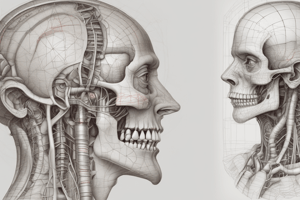Podcast
Questions and Answers
What separates the two layers of pleura surrounding the lungs?
What separates the two layers of pleura surrounding the lungs?
- Mediastinum (correct)
- Pleural cavity
- Pleural fluid
- Pulmonary ligament
Which part of the pleura is sensitive to temperature, touch, and pressure?
Which part of the pleura is sensitive to temperature, touch, and pressure?
- Parietal pleura (correct)
- Diaphragmatic pleura
- Mediastinal pleura
- Visceral pleura
What is the primary function of the trachealis muscle?
What is the primary function of the trachealis muscle?
- Protect against foreign objects
- Support the trachea structure
- Regulate airflow through the trachea (correct)
- Facilitate swallowing
At which vertebral levels does the trachea divide into the right and left primary bronchi?
At which vertebral levels does the trachea divide into the right and left primary bronchi?
Which layer is NOT part of the trachea's four structural layers?
Which layer is NOT part of the trachea's four structural layers?
What innervates the costal pleura?
What innervates the costal pleura?
What anatomical feature extends into the interlobar fissures of the lungs?
What anatomical feature extends into the interlobar fissures of the lungs?
Which of the following best describes the blood supply of the trachea?
Which of the following best describes the blood supply of the trachea?
What is the primary role of the carina in the respiratory system?
What is the primary role of the carina in the respiratory system?
Which bronchi supply each lobe of the lungs?
Which bronchi supply each lobe of the lungs?
What structural change occurs in the bronchi as they branch into smaller airways?
What structural change occurs in the bronchi as they branch into smaller airways?
What distinguishes the right primary bronchus from the left primary bronchus?
What distinguishes the right primary bronchus from the left primary bronchus?
What is the primary functional unit of the lung?
What is the primary functional unit of the lung?
Which type of blood vessel supplies the alveoli with oxygen-rich blood?
Which type of blood vessel supplies the alveoli with oxygen-rich blood?
What area of the lung is affected by the cardiac notch?
What area of the lung is affected by the cardiac notch?
Where are the pulmonary arteries located relative to other structures at the hilum of the lung?
Where are the pulmonary arteries located relative to other structures at the hilum of the lung?
Which of the following best describes the cross-section of a bronchopulmonary segment?
Which of the following best describes the cross-section of a bronchopulmonary segment?
Which branch of the autonomic nervous system induces bronchodilation?
Which branch of the autonomic nervous system induces bronchodilation?
What type of pleura lines the surface of the lungs?
What type of pleura lines the surface of the lungs?
Which of the following is a correct feature of the left lung?
Which of the following is a correct feature of the left lung?
What is the primary purpose of the lymphatic drainage in the lungs?
What is the primary purpose of the lymphatic drainage in the lungs?
Flashcards are hidden until you start studying
Study Notes
Thoracic Cavity and Mediastinum
- The thoracic cavity is enclosed by the rib cage, diaphragm, and thoracic vertebrae.
- Mediastinum separates the left and right pleural cavities, containing the heart, large vessels, trachea, esophagus, and thymus.
- Boundaries include the sternum anteriorly, thoracic vertebrae posteriorly, and diaphragm inferiorly.
Lower Respiratory System Components
- Includes the trachea, bronchi, bronchioles, lungs, and alveoli.
- Tracheobronchial tree branches into primary, secondary, and tertiary bronchi.
Tracheobronchial Tree
- Trachea extends from the cricoid cartilage (C6) to carina (T4-T5) with a length of 11.25 cm (adult).
- Divides into right and left primary bronchi; right bronchus is shorter, wider, and more vertical than the left.
- Trachea has four layers: mucosa, submucosa, hyaline cartilage, and adventitia, supported by 16-20 C-shaped cartilaginous rings.
Lungs and Lung Roots
- Lungs exhibit a conical shape with an apex and base.
- Right lung has three lobes (superior, middle, inferior); left lung has two lobes (superior, inferior).
- Lung roots include bronchi (most posterior), pulmonary arteries (most superior), and pulmonary veins (most inferior).
Pleura Arrangement
- Composed of two layers: parietal pleura (lines thoracic cavity) and visceral pleura (covers lungs).
- Costodiaphragmatic recess provides space for lung expansion during breathing.
- Pleural fluid within the pleural cavity facilitates smooth lung movement.
Innervation of Pleura
- Parietal pleura is innervated by intercostal and phrenic nerves, sensitive to touch and pressure stimuli.
- Visceral pleura is autonomically innervated by the pulmonary plexus, sensitive to stretch.
Bronchi Anatomy
- Primary bronchi further divide into secondary (lobar) bronchi for each lobe, and tertiary (segmental) bronchi for each segment.
- Bronchi structure changes with branching: incomplete cartilage rings transition to cartilage plates.
Lung Lobules and Acini
- Each lung lobe consists of lobules, functional units containing bronchioles, arterioles, venules, and alveoli.
- Respiratory bronchioles lead to alveolar ducts and sacs where gas exchange occurs.
Blood Supply to Lungs
- Lungs receive blood from bronchial arteries (from the aorta) and pulmonary arteries (from the right ventricle).
- Pulmonary veins carry oxygenated blood back to the left atrium.
Lymphatic Drainage of Lungs
- Lymph flows from lung surfaces to hilum, via bronchopulmonary nodes to the tracheobronchial nodes and bronchomediastinal trunk.
Surface Anatomy of Lungs and Pleura
- Apex of the lung located above the first rib; anterior border features a cardiac notch on the left side.
- Lower borders at the 6th rib (midclavicular), 8th rib (midaxillary), and 10th rib (vertebral).
- Horizontal fissure aligns with the 4th rib; oblique fissure follows the 6th rib's course.
Clinical Significance
- Understanding lower respiratory tract anatomy is critical for diagnosing conditions like pneumonia, pleuritis, and lung tumors.
- Knowledge of pleural recesses aids in procedures like thoracentesis and chest tube placements.
Studying That Suits You
Use AI to generate personalized quizzes and flashcards to suit your learning preferences.





